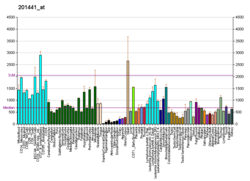| COX6B1 | |||||||||||||||||||||||||||||||||||||||||||||||||||
|---|---|---|---|---|---|---|---|---|---|---|---|---|---|---|---|---|---|---|---|---|---|---|---|---|---|---|---|---|---|---|---|---|---|---|---|---|---|---|---|---|---|---|---|---|---|---|---|---|---|---|---|
| Identifiers | |||||||||||||||||||||||||||||||||||||||||||||||||||
| Aliases | COX6B1, COX6B, COXG, COXVIb1, cytochrome c oxidase subunit 6B1, MC4DN7 | ||||||||||||||||||||||||||||||||||||||||||||||||||
| External IDs | OMIM: 124089; MGI: 107460; HomoloGene: 39658; GeneCards: COX6B1; OMA:COX6B1 - orthologs | ||||||||||||||||||||||||||||||||||||||||||||||||||
| |||||||||||||||||||||||||||||||||||||||||||||||||||
| |||||||||||||||||||||||||||||||||||||||||||||||||||
| |||||||||||||||||||||||||||||||||||||||||||||||||||
| |||||||||||||||||||||||||||||||||||||||||||||||||||
| Wikidata | |||||||||||||||||||||||||||||||||||||||||||||||||||
| |||||||||||||||||||||||||||||||||||||||||||||||||||
Cytochrome c oxidase subunit 6B1 is an enzyme that in humans is encoded by the COX6B1 gene. Cytochrome c oxidase 6B1 is a subunit of the cytochrome c oxidase complex, also known as Complex IV, the last enzyme in the mitochondrial electron transport chain. Mutations of the COX6B1 gene are associated with severe infantile encephalomyopathy and mitochondrial complex IV deficiency (MT-C4D).
Structure
The COX6B1 gene, located on the q arm of chromosome 19 in position 13.1, contains 4 exons and is 10,562 base pairs in length. The COX6B1 protein weighs 10 kDa and is composed of 86 amino acids. The protein is a subunit of Complex IV, a heteromeric complex consisting of 3 catalytic subunits encoded by mitochondrial genes, and multiple structural subunits encoded by nuclear genes.
Function
Cytochrome c oxidase (COX), the terminal enzyme of the mitochondrial respiratory chain, catalyzes the electron transfer from reduced cytochrome c to oxygen. It is a heteromeric complex consisting of 3 catalytic subunits encoded by mitochondrial genes and multiple structural subunits encoded by nuclear genes. The mitochondrially-encoded subunits function in electron transfer, and the nuclear-encoded subunits may be involved in the regulation and assembly of the complex. This nuclear gene encodes subunit VIb. Three pseudogenes COX6BP-1, COX6BP-2 and COX6BP-3 have been found on chromosomes 7, 17 and 22q13.1-13.2, respectively.
Summary reaction:
- 4 Fe-cytochrome c + 8 Hin + O2 → 4 Fe-cytochrome c + 2 H2O + 4 Hout
Clinical significance
Mutations affecting the COX6B1 gene are associated with mitochondrial complex IV deficiency (MT-C4D), a disorder of the mitochondrial respiratory chain with heterogeneous clinical manifestations, ranging from isolated myopathy to severe multisystem disease affecting several tissues and organs. Features include hypertrophic cardiomyopathy, hepatomegaly and liver dysfunction, hypotonia, muscle weakness, exercise intolerance, developmental delay, delayed motor development, and mental retardation. Some affected individuals manifest a fatal hypertrophic cardiomyopathy resulting in neonatal death. A subset of patients manifest Leigh's syndrome. A COX6B1 R20C missense mutation has been linked to complex IV deficiency with encephalomyopathy, hydrocephalus, and hypertrophic cardiomyopathy.
Interactions
COX6B1 has been shown to have 548 binary protein-protein interactions including 547 co-complex interactions.
References
- ^ GRCh38: Ensembl release 89: ENSG00000126267 – Ensembl, May 2017
- "Human PubMed Reference:". National Center for Biotechnology Information, U.S. National Library of Medicine.
- "Mouse PubMed Reference:". National Center for Biotechnology Information, U.S. National Library of Medicine.
- Taanman JW, van der Veen AY, Schrage C, de Vries H, Buys CH (July 1991). "Assignment of the gene coding for human cytochrome c oxidase subunit VIb to chromosome 19, band q13.1, by fluorescence in situ hybridisation". Human Genetics. 87 (3): 325–7. doi:10.1007/bf00200913. PMID 1650756. S2CID 31341587.
- ^ "Entrez Gene: COX6B1 cytochrome c oxidase subunit Vib polypeptide 1 (ubiquitous)".
- Zong NC, Li H, Li H, Lam MP, Jimenez RC, Kim CS, Deng N, Kim AK, Choi JH, Zelaya I, Liem D, Meyer D, Odeberg J, Fang C, Lu HJ, Xu T, Weiss J, Duan H, Uhlen M, Yates JR, Apweiler R, Ge J, Hermjakob H, Ping P (October 2013). "Integration of cardiac proteome biology and medicine by a specialized knowledgebase". Circulation Research. 113 (9): 1043–53. doi:10.1161/CIRCRESAHA.113.301151. PMC 4076475. PMID 23965338.
- "Cytochrome c oxidase subunit 6B1". Cardiac Organellar Protein Atlas Knowledgebase (COPaKB). Archived from the original on 2018-07-19. Retrieved 2018-07-18.
- Voet D, Voet JG, Pratt CW (2013). "Chapter 18". Fundamentals of biochemistry: life at the molecular level (4th ed.). Hoboken, NJ: Wiley. pp. 581–620. ISBN 978-0-470-54784-7.
- "COX6B1". Genetics Home Reference. U.S. National Library of Medicine. Retrieved 3 April 2015.
- Abdulhag UN, Soiferman D, Schueler-Furman O, Miller C, Shaag A, Elpeleg O, Edvardson S, Saada A (February 2015). "Mitochondrial complex IV deficiency, caused by mutated COX6B1, is associated with encephalomyopathy, hydrocephalus and cardiomyopathy". European Journal of Human Genetics. 23 (2): 159–64. doi:10.1038/ejhg.2014.85. PMC 4297913. PMID 24781756.
- "548 binary interactions found for search term COX6B1". IntAct Molecular Interaction Database. EMBL-EBI. Retrieved 2018-08-25.
Further reading
- Taanman JW, Schrage C, Bokma E, Reuvekamp P, Agsteribbe E, De Vries H (June 1991). "Nucleotide sequence of the last exon of the gene for human cytochrome c oxidase subunit VIb and its flanking regions". Biochimica et Biophysica Acta (BBA) - Gene Structure and Expression. 1089 (2): 283–5. doi:10.1016/0167-4781(91)90027-J. PMID 1647217.
- Carrero-Valenzuela RD, Quan F, Lightowlers R, Kennaway NG, Litt M, Forte M (June 1991). "Human cytochrome c oxidase subunit VIb: characterization and mapping of a multigene family". Gene. 102 (2): 229–36. doi:10.1016/0378-1119(91)90082-M. PMID 1651883.
- Taanman JW, Schrage C, Ponne NJ, Das AT, Bolhuis PA, de Vries H, Agsteribbe E (September 1990). "Isolation of cDNAs encoding subunit VIb of cytochrome c oxidase and steady-state levels of coxVIb mRNA in different tissues". Gene. 93 (2): 285–91. doi:10.1016/0378-1119(90)90237-L. PMID 2172092.
- Taanman JW, Schrage C, Ponne N, Bolhuis P, de Vries H, Agsteribbe E (February 1989). "Nucleotide sequence of cDNA encoding subunit VIb of human cytochrome c oxidase". Nucleic Acids Research. 17 (4): 1766. doi:10.1093/nar/17.4.1766. PMC 331842. PMID 2537962.
- Schmidt TR, Goodman M, Grossman LI (March 2002). "Amino acid replacement is rapid in primates for the mature polypeptides of COX subunits, but not for their targeting presequences". Gene. 286 (1): 13–9. doi:10.1016/S0378-1119(01)00800-9. PMID 11943455.
- Sirchia R, Luparello C (May 2007). "Mid-region parathyroid hormone-related protein (PTHrP) and gene expression of MDA-MB231 breast cancer cells". Biological Chemistry. 388 (5): 457–65. doi:10.1515/BC.2007.059. PMID 17516841. S2CID 2286919.
External links
- Human COX6B1 genome location and COX6B1 gene details page in the UCSC Genome Browser.
- Mass spectrometry characterization of COX6B1 at COPaKB
This article incorporates text from the United States National Library of Medicine, which is in the public domain.
Categories:

